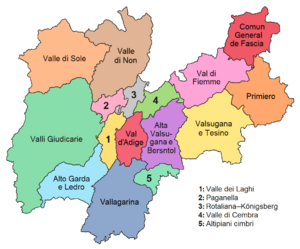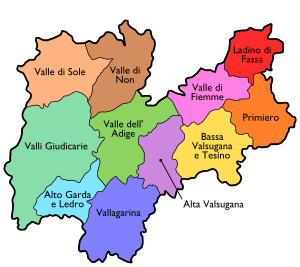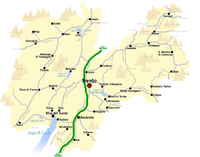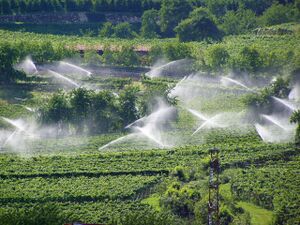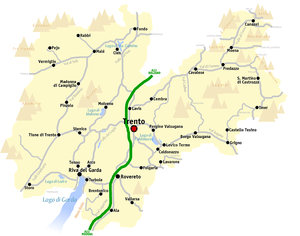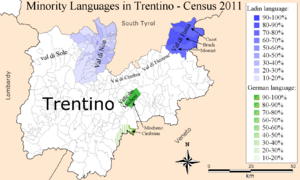ترنتينو
Autonomous Province of Trento
Provincia autonoma di Trento | |
|---|---|
| النشيد: Inno al Trentino | |
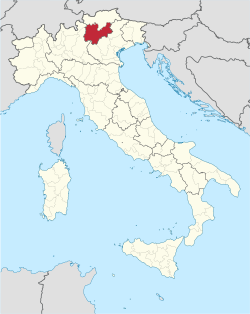 Map highlighting the location of Trentino in Italy | |
| الإحداثيات: 46°26′44″N 11°10′23″E / 46.44556°N 11.17306°ECoordinates: 46°26′44″N 11°10′23″E / 46.44556°N 11.17306°E | |
| Country | Italy |
| Region | Trentino-Alto Adige/Südtirol |
| Capital(s) | ترنتو |
| Comuni | 166 |
| الحكومة | |
| • President | Maurizio Fugatti (Lega) |
| المساحة | |
| • الإجمالي | 6٬212 كم² (2٬398 ميل²) |
| التعداد (1 January 2019) | |
| • الإجمالي | 541٬098 |
| • الكثافة | 87/km2 (230/sq mi) |
| منطقة التوقيت | UTC+1 (CET) |
| • الصيف (التوقيت الصيفي) | UTC+2 (CEST) |
| Postal code | 38100 |
| Telephone prefix | 0461, 0462, 0463, 0464, 0465 |
| لوحة السيارة | TN |
| GDP (nominal) | €20.5 billion (2018)[1] |
| GDP per capita | €38,000 (2018)[2] |
| HDI (2019) | 0.920[3] very high · 2nd of 21 |
| ISTAT | 022 |
مقاطعة ترنتينو ( Trentino ؛ اللادينية: [Trentin] Error: {{Lang}}: text has italic markup (help)), رسمياً مقاطعة ترنتو الذاتية، هي مقاطعة شمال إيطاليا متمتعة بالحكم الذاتي في إقليم ترينتينو التو اديجي عاصمتها مدينة ترينتو ، عدد سكانها 504.824 نسمة ومساحتها 6207 كم² وبها 223 بلدية وثاني أهم مدنها بعد العاصمة مدينة روڤرتو ، يحدها شمالا مقاطعة بولسانو، و من الشرق إقليم فينيتو عند مقاطعة بيلونو ومقاطعة فيشنزا ومقاطعة فيرونا، وغرباً إقليم لومبارديا عند مقاطعة بريشا ومقاطعة سوندريو.
يطابق منطقة ترنتينو التاريخي والجغرافي، وهو جزء من جنوب تيرول.
. . . . . . . . . . . . . . . . . . . . . . . . . . . . . . . . . . . . . . . . . . . . . . . . . . . . . . . . . . . . . . . . . . . . . . . . . . . . . . . . . . . . . . . . . . . . . . . . . . . . . . . . . . . . . . . . . . . . . . . . . . . . . . . . . . . . . . . . . . . . . . . . . . . . . . . . . . . . . . . . . . . . . . . .
الجغرافيا
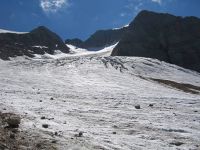
Trentino is a mountainous region. The Adige River flows through the central Trentino in a valley named after the river. The principal towns of Trentino lie in the Adige Valley, which has been a historical passage connecting Italy with Northern Europe. Among other important valleys are Non Valley, known for its apple production, Sole Valley, Giudicarie, which has been historically connected by Trento and Brescia, Fiemme and Fassa, Lagarina, Mocheni, Sugana Valley and many others.
The province has an area of 6,214 km2 (2,399 sq mi), and a total population of 524,826 (2010). There are 217 comuni (singular: comune), in the province.[4]
The Marmolada, at 3,343 m (10,968 ft) above sea level, is the highest mountain in the Dolomites. The glacier on the Marmolada is also a landmark. Other high mountains include the Monte Baldo, Carè Alto, Cermis, Crozzon di Brenta, Hintere Eggenspitze, Latemar, Paganella, Piz Boè, Presanella, Punta San Matteo and Vezzana.
التقسيم الإداري
Due to the division of the province into the 217 municipalities (Comuni/Gemeinden), often of small or even tiny size, in the late 1970s, eleven larger units known as districts (comprensori) were introduced. The municipalities forming a district elect the council for that district. However, this tier of government has provoked criticism, and, in 2006, a reform created fifteen more homogeneous "Valley Communities" (comunità di valle, Talgemeinden) and one territory including the municipalities of Trento, Cimone, Aldeno and Garniga Terme (see Municipalities of Trentino).
| # | الاسم | البلديات | السكان | العاصمة | خريطة |
|---|---|---|---|---|---|
| 1 | Comunità territoriale della Val di Fiemme | 9 | 18,567 | Cavalese | |
| 2 | Comunità di Primiero | 5 | 9,836 | Tonadico | |
| 3 | Comunità Valsugana e Tesino | 18 | 25,694 | Borgo Valsugana | |
| 4 | Comunità Alta Valsugana e Bersntol | 15 | 45,228 | Pergine Valsugana | |
| 5 | Comunità della Valle di Cembra | 7 | 10,854 | Cembra | |
| 6 | Comunità della Val di Non | 29 | 37,143 | Cles | |
| 7 | Comunità della Valle di Sole | 13 | 15,020 | Malè | |
| 8 | Comunità delle Giudicarie | 25 | 35,647 | Tione di Trento | |
| 9 | Comunità Alto Garda e Ledro | 7 | 42,955 | Riva del Garda | |
| 10 | Comunità della Vallagarina | 17 | 78,482 | Rovereto | |
| 11 | Comun General de Fascia | 6 | 9,195 | Pozza di Fassa | |
| 12 | Magnifica Comunità degli Altipiani Cimbri | 3 | 4,442 | Lavarone | |
| 13 | Comunità Rotaliana-Königsberg | 7 | 25,953 | Mezzocorona | |
| 14 | Comunità della Paganella | 5 | 4,731 | Andalo | |
| 15 | Val d'Adige territory | 4 | 110,061 | none | |
| 16 | Comunità della Valle dei Laghi | 3 | 9,349 | Vezzano |
As of 2009, the only municipalities with a population over 20,000 were Trento, Rovereto, and Pergine Valsugana.
الاقتصاد
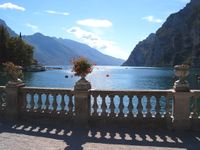
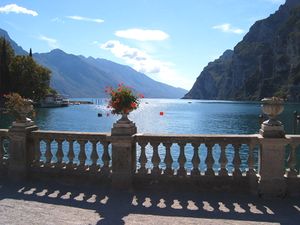
Gross domestic product (GDP) of the region was 20.5 billion euros in 2018, accounting for 1.2% of Italy's economic output. GDP per capita adjusted for purchasing power was 37,900 euros or 126% of the EU27 average in the same year. The GDP per employee was 119% of the EU average.[5]
Despite the overwhelmingly mountainous nature of the territory, agriculture remains important. Farms often join to form larger cooperatives. The most important produce comprises apples (50% of national production, together with South Tyrol) and other fruit, vegetables (primarily in the Val di Gresta), and grapes. Important especially for their quality, the latter are used for the production of dry and sparkling wines.
In January 2008, the Edmund Mach Foundation was established to promote research, training and services in the agricultural, agri-food and environmental fields.
The primary industries, often small and medium-sized, are concentrated in Valsugana, Vallagarina and the Adige Valleys. Sectors include textiles, mechanics, wood and paper productions. Also important is the production of hydro-electric energy.
Tourism is the mainstay of the provincial economy. The main resorts include: Madonna di Campiglio, San Martino di Castrozza, Fiera di Primiero, Canazei, Moena, Cavalese, Folgaria, Folgarida-Marilleva, Riva del Garda and Levico Terme, Comano Terme and Roncegno, these last three being renowned thermal stations.
The unemployment rate stood at 5.3% in 2020.[6]
. . . . . . . . . . . . . . . . . . . . . . . . . . . . . . . . . . . . . . . . . . . . . . . . . . . . . . . . . . . . . . . . . . . . . . . . . . . . . . . . . . . . . . . . . . . . . . . . . . . . . . . . . . . . . . . . . . . . . . . . . . . . . . . . . . . . . . . . . . . . . . . . . . . . . . . . . . . . . . . . . . . . . . . .
Transport
The Trentino province is crossed by the main road and rail connections between Italy and Germany. These include the Brenner A22 motorway and road which passes through the Etsch/Adige Valley. A regional project of switching much of the road traffic to railways is currently under consideration.
The province has two more railways: the Valsugana Line, connecting Trento to Venice and the Trento-Malè-Marilleva railway between Trento and Malè.
Demographics
In 2019 the population of Trentino was 541,098. The highest concentration of the population is located around the capital city of Trento, and the southern parts. The whole region is divided up into 175 municipalities.
Languages
The majority of the Trentino population is Italian-speaking with its local dialects. The region is also home to three indigenous linguistic minorities, which are Ladin, Mócheno and Cimbrian.[7] All languages are protected by regional and provincial laws, statutes, and regulations.
After World War II and the devolution of power to regional authorities, a change in policy slowly began, which gained momentum in the 1990s. Since then a number of far-reaching laws and regulations have been passed and implemented, that protect and promote the use of these three languages and the unique cultural heritage and identity. This has for example been extended to school curricula in the regional languages and street signs becoming bilingual. All three minorities have their own cultural institute which were decreed by national law and receive state funds. The purpose of these cultural institutes is to safeguard and promote the respective culture and languages.
The Ladin minority is found in the Fassa Valley, in the municipalities of Canazei (Cianacei), Campitello di Fassa (Ciampedèl), Mazzin (Mazin), Moena, Soraga and Sèn Jan di Fassa. In the census of 2001, 16,462 inhabitants of Trentino declared Ladin as their native language.[8]
Mócheno is still spoken in the municipalities of Frassilongo (Garait), Palù del Fersina (Palai en Bersntol) and Fierozzo (Vlarötz), while the Cimbrian language is spoken in Luserna (Lusérn).[9] The 2001 census found there were 2,276 native Mócheno and 882 Cimbrian speakers.[8] The linguistic breakdown according to the census of 2001 is:[10]
| Language | Number | Percentage |
|---|---|---|
| Italian | 457,397 | 95.8 |
| Ladin | 16,462 | 3.5 |
| Mócheno | 2,276 | 0.5 |
| Cimbrian | 882 | 0.2 |
| Total | 477,017 | 100 |
The Nones language hails from the Non Valley and is considered by some[من؟] linguists a variant of Ladin.[بحاجة لمصدر] Estimates range up to 30,000 speakers. The Solandro language is also under debate as to whether it is a dialect of Ladin or a separate language. Native speakers are mainly found in the Sole Valley and are estimated to be up to 15,000. Both idioms are alternatively considered as dialects within the range of Gallo-Romance languages. There is no official census to date that has Nones and Solandro as officially distinct languages. The total number of Ladin speakers in the census of 2001 exceeds the population of around 7,500 in the Fassa Valley. A number of Nones and Solandro speakers identified as Ladin speakers, while others chose not to exercise that option due to the disagreement whether or not their languages are Ladin or a separate idiom.
Culture
The Trentino is a region of cultural encounters. Already in the past Germans, Italians and Ladins joined in this area. The alpine province is a piece of land, in which mountain passes and elevated plains join hilly valleys and plains and in which different people and cultures join. Its history, but also the relatively insular geographic position of some valleys led to an extraordinary richness in culture and many customs and traditions that have been kept alive up to the present. Also some minority groups and gastronomic peculiarities have been preserved till now.[11]
Museums
In the territory of the Province there are numerous museums, which have had significant development over the last twenty years by the financial resources of the Province. Among the main ones:
- the modern and contemporary art museum of Trento and Rovereto (MART), inaugurated in 2002, based in Corso Bettini in Rovereto. The modern architectural structure was designed by Mario Botta and fits harmoniously into the historical fabric of the city. MART can boast an extensive permanent collection of contemporary works and aims to take on an increasingly international dimension.
- the it (MUSE (museum)), museum of the sciences of Trento.
- The Civic Museum of Rovereto, founded in 1851 and among the oldest Italian museums;
- the Buonconsiglio museum near the castle of the same name and the Historical Museum in Trento in via Torre d'Augusto;
- the Tridentine Museum of Natural Sciences, located in Trento;
- the aeronautics museum, dedicated to Gianni Caproni (based in Mattarello);
- the museum of the uses and customs of the Trentino people, one of the major ethnographic and material culture museums of the entire Alpine area, with headquarters in San Michele all'Adige;
- the Italian historical museum of the War of Rovereto, dedicated to the First World War, hosted at the city's castle.
- the geological museum of the Dolomites in Predazzo
- Padre Kino Museum located in Segno in the Val di Non chronicles the life of missionary explorer Eusebio Kino and the indigenous people of today's borderlands of Arizona and Sonora.
Also worthy of note are the cultural institutes and museums dedicated to the three minorities of the Province, the Istitut cultural Ladin "majon di fascegn" in Val di Fassa and the "Kulturinstitut Bersntol - Lusérn" for the promotion of German-speaking minorities mòchene and Cimbre.
Castles
In the region there are numerous castles. With the financial aid of Province, some of them could be restored and are now open to the public. Here the most important:
- Castel del Buonconsiglio , in Trento;
- Castel Thun, in the Val di Non;
- Castel Stenico, in the Vallagarina;
- Castel Beseno, in the Adige Valley;
- Castel Toblino, in the Valle del Sarca;
- Castel Cles, near Cles in the Val di Non;
- Arco Castle, in Arco.
Sports and recreation
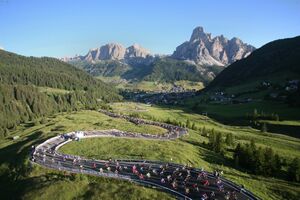
The region offers many opportunities for mountain climbing and trekking and winter sports. Important winter events are the world championships organised by the International Ski Federation (FSI) such as the Nordic ski 1991, 2003 and 2013, snowboarding 2001 and freestyle ski championship 2007, as well as the Adamello Ski Raid and Marcialonga. The Tour de Ski has since 2007 had its conclusion in Val di Fiemme with the Final Climb stage up the alpine skiing course on Alpe Cermis.
During the spring and summer, cycling is a big event in the region, such as the Giro del Trentino and Maratona dles Dolomites over the mountain passes. Cross country racing such as the Cross della Vallagarina and the 10-kilometre road running competition Giro al Sas also take place.
Association football is a popular ball sport in Trentino. Teams within the region are U.S. Alta Vallagarina, A.C. Mezzocorona, A.S.D. Porfido Albiano and Trento Calcio 1921.
Trentino Volley is a professional Italian volleyball team. It has played in the Italian Volleyball League without interruption since 2000, while Aquila Trento is a basketball team in the Italian top league.
انظر أيضاً
. . . . . . . . . . . . . . . . . . . . . . . . . . . . . . . . . . . . . . . . . . . . . . . . . . . . . . . . . . . . . . . . . . . . . . . . . . . . . . . . . . . . . . . . . . . . . . . . . . . . . . . . . . . . . . . . . . . . . . . . . . . . . . . . . . . . . . . . . . . . . . . . . . . . . . . . . . . . . . . . . . . . . . . .
المصادر
- ^ "Eurostat – Tables, Graphs and Maps Interface (TGM) table". European Commission. 12 August 2011. Retrieved 2 September 2019.
- ^ "Regional GDP per capita ranged from 30% to 263% of the EU average in 2018" (Press release). ec.europa.eu. Retrieved 1 September 2020.
- ^ "Sub-national HDI - Area Database - Global Data Lab". hdi.globaldatalab.org (in الإنجليزية). Retrieved 2019-09-13.
- ^ Province: Trento - Total Resident Population on 1st January 2010 by sex and marital status Archived 3 مارس 2016 at the Wayback Machine, ISTAT data.
- ^ "Regional GDP per capita ranged from 30% to 263% of the EU average in 2018". Eurostat.
- ^ "Unemployment NUTS 2 regions Eurostat" (in الإنجليزية).
- ^ "Lombard".
- ^ أ ب "Tav. I.5 - Appartenenza alla popolazione di lingua ladina, mochena e cimbra, per comune di area di residenza (Censimento 2001)" (PDF). Annuario Statistico 2006 (in الإيطالية). Autonomous Province of Trento. 2007. Retrieved 2011-05-12.
- ^ خطأ استشهاد: وسم
<ref>غير صحيح؛ لا نص تم توفيره للمراجع المسماةSpecial Statute for Trentino-Alto Adige - ^ "Trentino in figures" (PDF). Table 9 - Declarations of which language group belong to/affiliated to - Population Census 2001. Retrieved 2011-05-14.
- ^ "Tradition and culture - Trentino - Italy". trentino.com. Retrieved 16 January 2019.
وصلات خارجية
- CS1 الإيطالية-language sources (it)
- Short description is different from Wikidata
- Articles with hatnote templates targeting a nonexistent page
- Coordinates on Wikidata
- Lang and lang-xx template errors
- جميع المقالات الحاوية على عبارات مبهمة
- جميع المقالات الحاوية على عبارات مبهمة from January 2013
- Articles with unsourced statements from January 2013
- مقاطعات إيطاليا
- مقاطعة ترنتو
- مناطق النبيذ في إيطاليا
- تيرول (منطقة)



